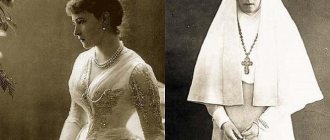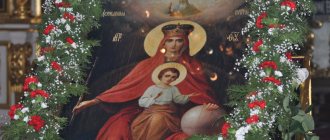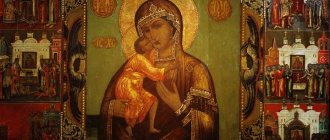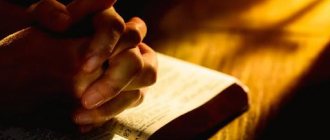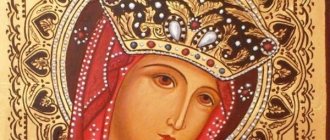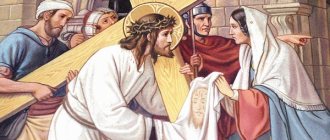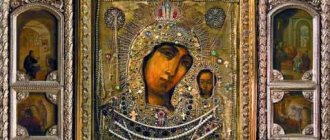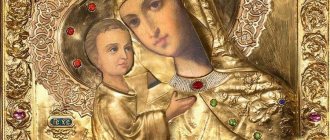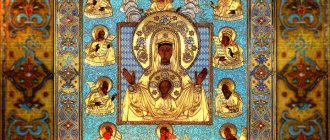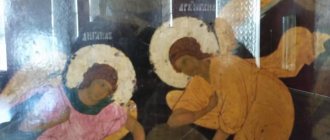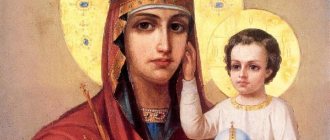Now this icon is invariably present in every church and occupies a central position in the altar composition. After all, the plot of the icon of the Baptism of the Lord represents one of the most significant events of the Savior’s earthly journey: John the Baptist baptizes Christ in the waters of the Jordan River. Moreover, on this significant day, Christ not only received baptism, but also all the components of the Holy Trinity manifested themselves, that is, Christ himself, the Most High Lord and the Holy Spirit.
Contents of the icon
Just like many other icon paintings, this one may have some differences depending on the time of creation of the icon and other factors. The content has changed over the centuries, but, one way or another, there have always been two main figures:
- John the Baptist;
- The Holy Trinity.
This is exactly how one should understand the icon of the Baptism of the Lord, because the vision of only John the Baptist and Christ is a little limited. In fact, in the image the Almighty Lord appears before us in symbolic form as the Holy Trinity:
- Christ is an earthly hypostasis;
- dove is a symbol of the Holy Spirit;
- The Lord is in invisible form.
Thus the Trinity is formed. The Lord himself is not depicted, since none of the people can see him. At the same time, those who understand the content of the icon understand and know that the third hypostasis of the Trinity is also present there in an invisible form.
In the composition, as a rule, Christ is located in the center, standing in the waters of the Jordan River, which he previously consecrated so that other people could wash away their sins. On one side stands John the Baptist, sometimes with a cross in one hand, and with the other hand he points to Christ. On the other side there are angels or apostles, the angels here serve St. John, just as deacons serve the priests in the church.
In the upper part, an oval symbolically depicts the firmament from which a dove (the Holy Spirit) descends. On the top sides there are high mountains near the Jordan, which carry symbolic meaning and often look like a ladder - they personify spiritual ascent.
Iconography of the Baptism of the Lord
The Feast of the Epiphany is one of the most ancient and in this sense second only to Easter. The sacrament of Baptism began to be performed in Christian communities long before the celebration was established, and scenes of the Baptism of the Lord are the oldest in Christian art. In ancient baptisteries - rooms for receiving the Sacrament - a large image of Baptism was located in the space under the dome, and later on the vaults and walls. Then images of the Baptism of the Lord began to appear on wood, stone and bone carvings; on body crosses, reliquaries and external crosses participating in religious processions.
The festival has long had several names: Epiphany, Feast of Lights, Epiphany.
At first, the holidays of the Nativity of Christ and the Epiphany of the Lord, and then, from the 4th century, separately, separately. However, the church services for Christmas and Epiphany remain much in common: both holidays are preceded by Christmas Eve, and the time between them is marked by the absence of fasting. Some icons of the Epiphany depict the night starry sky, which also recalls the event of the Nativity of Christ.
The two evangelists begin the biography of the Son of God with His Baptism. It’s the same on icons: for example, on one Novgorod image “The Earthly Life of Christ” from the turn of the 14th–15th centuries, the narrative in the stamps begins with the image of the Epiphany. During the Baptism of the Savior, all three Persons of the Holy Trinity appeared. The icons depict God the Father, sometimes in a cloudy celestial segment, God the Son being baptized in the Jordan, and the Holy Spirit descending in the form of a dove.
All four evangelists talk about the Baptism of the Lord, while the gospel narrative is laconic, and the iconographic plot is also simple and clear. In the 2nd–3rd centuries, when the iconography of the holiday was still at the stage of formation, the wall paintings of the catacombs depicted Jesus Christ and the prophet John the Baptist, and above them the Holy Spirit in the form of a dove; The Psalms were also illustrated in a brief summary with scenes of Baptism. Sometimes in catacomb painting a dove held a branch in its beak, referring to the familiar story of the forefather Noah, since the biblical story of the Flood is one of the Old Testament prototypes of the Baptism of the Lord (1 Pet. 3:20); in later icons this image is also repeated as understandable and very close.
Christ is depicted standing in river streams, naked or with a girdle; sometimes he is dressed in a tunic and himation. He stands straight or leans towards the prophet John. Sometimes Christ slightly steps forward with his foot and looks at the person praying. Such icons acquire the quality of a prayer image - the Almighty of the world looks down from the icon.
Christ blesses the waters of the Jordan - this image has appeared in miniatures and mosaics since the 10th century. On the water, to the left of Jesus, is inscribed the image of the Cross as a sign of the consecration of the world's waters. According to St. Gregory the Theologian, the Lord “was baptized not for the sake of his own purification, but to sanctify the waters,” and therefore the sign of the Cross indicates the sanctification of the watery nature. The hymns of St. Ephraim the Syrian contain luminous images, for example: “... the whole Jordan shone from the sparkle of His light,” “the water consecrated by baptism received from Me fire and the Spirit.” Icon painters also depict red fish, a scarlet Cross in river streams, water and banks covered with luminous reflections.
Russian icons depict the Jordan as the pilgrims described it: the river has two steep banks and a fast current. The depth of the reservoir can be shown in different ways: sometimes the water reaches just to the ankles, sometimes the waves envelop Christ like a veil, or foam like lambs, or are depicted on top of Him. In the upper part of the icon, the Jordan is divided “here and there” into two streams, as stated in the troparion of the holiday: by the way, in the church service the division of the river is compared with the miracle of the prophet Elisha, when, by the grace of Saint Elijah, he forced the Jordan streams to part.
The hymns contain luminous images: “the water sanctified by baptism received from Me fire and the Spirit”
The two banks are not far from each other: the angels and the Forerunner, standing on opposite sides of the river, almost touch their heads - the prayer’s attention is drawn simultaneously to both Christ and the prophet John. And the waves of the Jordan, painted with long strokes, extending in different directions, additionally unite the images of Christ, John the Baptist, and later the apostles and angels into a single whole. Later icons depict a wide river bed and one hilly bank covered with intricate vegetation. The Prophet John stands on the shore, and an angel hovers on the clouds, right above the river streams.
The bank of the Jordan in sacred images is covered with palm trees, and those baptized in the icon of the Epiphany sometimes hold palm branches in their hands.
The topography and landscapes of Palestine were well known in Rus'. Pilgrimage to Jerusalem began in the 4th century, and pilgrims of Ancient Rus' have been appearing there since the end of the 11th century. Pilgrims visiting shrines brought palm branches mainly from the Jericho Valley.
John the Baptist, placed on the high, sometimes rocky bank of the Jordan, towers over Christ standing in the water. Saint John is depicted wearing camel hair or hair shirt; sometimes he is dressed in a tunic or himation. The prophet holds a scroll or cross on a long shaft in his left hand. The right hand of the saint, stretched over the head of the Savior, is the literal center of the composition. This gesture is spoken of many times in the chants of the holiday: “The Baptist... now the hand of the right hand trembles”, when “The Most Pure Son bows His forerunner” - liturgical texts serve as a semantic source, inspiring epithets, like wings, for images.
Angels numbering from two to seven stand on the banks of the river or fly to Christ from heaven. The Gospel does not tell us about their presence at the Baptism of the Lord, but they, like the recipients of the font, hold the veils in their hands. Sometimes angels are depicted opening the doors of heaven, according to the word of the evangelists that at Baptism the sky was opened.
The icon of the Baptism of the Lord may contain allegories; they came to Christian painting from the Greco-Roman world.
All these images are monochrome, that is, one color - the same color as the water jets - and their volume is revealed by spaces. The allegorical image of Jordan himself is interesting: he is an old man holding a blanket or a stalk of reeds. He rests his hand on an overturned bowl or jug. The introduction into this composition of details not mentioned in the gospel narrative, even poses and gestures, is explained by the texts of the holiday service. These images were based on the words of the psalm: “ See the sea and run, Jordan return back…”
(Ps. 113: 3), which are considered as a prophecy about the Baptism of the Lord. The river on the icon “seethes”, as if going back, and the old man in the form of the Jordan turns from the viewer to Christ or in the opposite direction, pouring water from the vessel he is holding in his hands. And the allegory of the sea in the form of a wife is depicted in motion, in “running.”
The introduction into the composition of details not mentioned in the gospel narrative is explained by the texts of the holiday service
Icons sometimes depict people being baptized. Evangelist Luke tells that Christ was baptized after the people: “ When all the people were baptized, and Jesus...
"(Luke 3:21). Since ancient times, catechumens before baptism took off their clothes, which symbolized the putting aside of the “old man,” and after receiving the Sacrament, the baptized put on new, light “dresses.” It’s the same on the icons: men of different ages take off their clothes and swim. Some of them stand on both banks of the river; elders, youths and women stand out in the crowd holding babies in their arms; Groups of cripples, wretched and needy people are introduced into the composition of later icons. The gestures of people, in contrast to the main characters, are animated: those being baptized turn their heads towards each other, nod, shrug their shoulders in surprise, there is animation and joy in their poses. Fishes are depicted in the water, symbolizing human souls.
Thus, we see that the icon of the Baptism of the Lord depicts the Holy Trinity, the angelic world and the saints. Sometimes the apostles Peter and Andrew stand behind John, the gesture of their hands raised to their chests with palms facing outward speaks of a silent conversation: they are amazed at the great Sacrament.
The sacred meaning of the icon for the Baptism of the Lord
In a historical sense, the icon of the Epiphany states the fact of Christ’s participation in the rite of baptism. As you know, John the Baptist spent some time in the Mocheron desert, where he baptized the Jews. The people of Israel trusted the prophet and went to be baptized in order to get rid of their sins.
The Savior himself came to the waters of the Jordan and asked John for baptism, but he rejected the request, saying: “I myself need to be baptized by you.” Christ objected and called on John to fulfill the prophecy.
Thus, at a deep level, the icon speaks of Christ’s humility before the destined. The Lord himself strengthened him with the famous words: “You are my beloved son...”. John also humbles himself, touching the Lord with his right hand and washing him with water, performing the ritual.
One of the surviving Christian relics is the very hand of John the Baptist with which he touched the Lord. The Right Hand of St. John remains incorrupt to this day.
This is interesting
The icon of the Baptism of the Lord captures the fulfillment of what was ordained by the Lord, that is, his will, that is, the truth. Accordingly, the observer is not only involved in the holy sacrament, but also in the highest truth.
Also interesting is the symbolism of the two banks of the Jordan:
- where John stands is called “that” shore;
- where the angels are - “this” shore.
Christ, in turn, becomes a kind of connecting link between them. However, the icon of the Epiphany of the Lord also makes the sacrament of baptism itself such a link.
Where the angels stand is Israel - the holy land. Accordingly, crossing the Jordan symbolically means crossing to the Holy Land.
Of course, we are not talking about geographical magnitudes, but about the spiritual path that Christ opens for everyone.
As you can see, the sacred meaning of the Baptism of the Lord icon is deep and multifaceted; here every detail is in deep unity with the rest, ultimately creating a complete composition that tells the story of the Christian faith. That is why this plot is included in various services. Prayer in front of this image helps to strengthen one’s faith and advance on the spiritual path.
What do they ask for in front of the icon?
Prayers before the miraculous icon “Baptism of the Lord” help believers in resolving various worldly problems, including the most difficult and hopeless situations. The image has great power and bestows Divine protection and grace on those who turn.
Orthodox Christians turn to the shrine, trusting in the Lord’s help and assistance in the hope of:
- healing of physical and mental illnesses;
- calming suffering and sorrow;
- getting rid of melancholy and despondency;
- guidance on the true path of those who have strayed from righteous guidelines in worldly life;
- strengthening faith, resilience and fortitude;
- cleansing from sin and taking the righteous path of correction;
- restoration of justice;
- improving the welfare of honest workers.
You can approach the shrine within the walls of an Orthodox church and at home. For an independent prayer service, it is recommended to purchase an image and place it at home. The shrine is especially revered on the feast of Epiphany, which is celebrated annually on January 19. On this day, solemn prayer texts are read in front of the icon.
All water for Epiphany, by the will of God, is considered holy. Endowed with special power, Epiphany water washes away sins from repentant sinners, cleanses the body and soul, and has healing properties. On this day, it is customary to plunge into water and pray fervently in front of the holy image.
The icon “Baptism of the Lord,” placed at home, protects its inhabitants from the machinations of evil forces and negative influences, becoming a protective talisman for the family.
Prayer before the icon of the Baptism of the Lord
Troparion, tone 1
In the Jordan I am baptized to Thee, O Lord, the Trinitarian adoration appeared: for the voice of the Parents testified to Thee, naming Thy beloved Son, and the Spirit, in the form of a dove, announced the affirmation to Thy words. Appear, O Christ God, and enlighten the world, glory to Thee.
Kontakion, tone 4
Thou hast appeared this day to the whole universe, and Thy light, O Lord, has appeared upon us, in the minds of those who sing Thee; You came and you appeared, the unapproachable Light.
Greatness
We magnify You, Life-Giving Christ, for our sake now baptized in the flesh by John in the waters of the Jordan.
The Baptism of the Lord was celebrated even at a time when the apostles of Christ themselves were alive
The Baptism of the Lord began to be celebrated when the apostles themselves were alive. At the very beginning, Christmas and Epiphany were celebrated on the same day, and it was called Epiphany.
IV
from this century the Epiphany of the Lord began to be celebrated as a separate holiday
But since the 4th century, Epiphany began to be celebrated as a separate holiday. In the very first centuries, converts were baptized on the feast of Epiphany, then this was the name given to catechumens, those people who were not baptized.
Afterwards, this day began to be called the Day of Enlightenment, the Feast of Lights, as a sign that the Sacrament of Baptism itself cleanses a person from all sin, thereby enlightening him with the Light of Christ. Then people were illuminated in ponds.
Founder of the Kingdom of God
By this time, Jesus Christ, who lived in Nazareth and was not yet known to anyone, was thirty years old. According to Jewish law, this was the age at which a man received the right to become a teacher and be called “rabbi.” From then on, he began his public ministry, the purpose of which was to show people the way to the Kingdom of God, that is, to a new humanity reborn after the Fall.
The gateway to it was baptism, since without cleansing from sins and repentance the entrance there was closed. Jesus Christ, as the founder of this Kingdom, had to be the first to enter it, and therefore, despite his sinlessness, he could not bypass its cleansing gates. This was the reason that one day John the Baptist, while delivering his next sermon, saw Jesus approaching him.
The very first icon of the Baptism of the Lord was found in the Roman catacombs in the 3rd century
The very first icon appeared around the 3rd century and was found in the Roman catacombs. But only one part of this icon, the left one, has survived to this day.
This is what the first icon looks like, which was found in the Roman catacombs in the 3rd century. Only one left part has survived to this day.
In the first icon, Jesus is depicted as a very young man, which, frankly speaking, is very strange. But the images of the 3rd and 4th centuries precisely indicate that the Lord is depicted in the form of a Youth.
The youth on the icon suggests that this is the eternity of the Divine Savior.
More modern icons look a little different. On them the Lord is depicted at the age of 30 - 33 years.
The most famous image of the Epiphany is in Italy.
The Ravenna mosaic dates back to the 5th - 6th centuries. It is this image that seems to be a continuation of the ancient tradition of icon painting. The Lord is again depicted as a completely young man, naked. But later artists began to depict Christ in a girdle.
The Russian icon of Baptism was painted by master Mikhail in the 17th century. The icon is in the State Russian Museum in St. Petersburg.
Many will find it strange why it is not in the temple. In fact, her story is sad. There is some kind of violation on the icon; it depicts God the Father.
There is also an icon of Andrei Rublev. His icon has many hidden meanings. The Savior is in the waters of the Jordan River. Jesus' right hand is bent and indicates the person's place next to God himself.
The mountains bow before Jesus, as if repeating the bow of the prophet John. The river is directed high up. And the gorge symbolizes Hell, into which the Savior descended to bring Adam out of there.
This icon is the first image of the Baptism of the Lord in Rus'. Before this, people used Byzantine icons.
